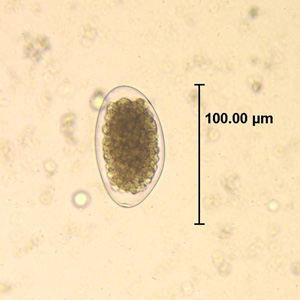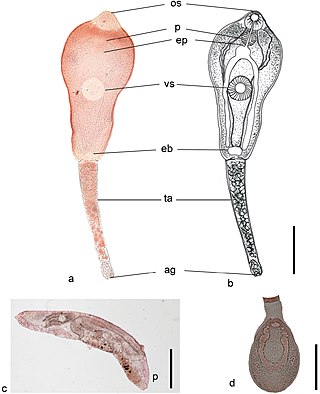
Digenea is a class of trematodes in the Platyhelminthes phylum, consisting of parasitic flatworms with a syncytial tegument and, usually, two suckers, one ventral and one oral. Adults commonly live within the digestive tract, but occur throughout the organ systems of all classes of vertebrates. Once thought to be related to the Monogenea, it is now recognised that they are closest to the Aspidogastrea and that the Monogenea are more closely allied with the Cestoda. Around 6,000 species have been described to date.

Plagiorchiida is a large order of trematodes, synonymous to Echinostomida. They belong to the Digenea, a large subclass of flukes. This order contains relatively few significant parasites of humans.

Echinostomata is a suborder of the parasitic flatworm order Plagiorchiida. The suborder contains numerous species that are parasitic in humans.

Trichostrongylus species are nematodes, which are ubiquitous among herbivores worldwide, including cattle, sheep, donkeys, goats, deer, and rabbits. At least 10 Trichostrongylus species have been associated with human infections. Infections occur via ingestion of infective larvae from contaminated vegetables or water. Epidemiological studies indicate a worldwide distribution of Trichostrongylus infections in humans, with the highest prevalence rates observed in individuals from regions with poor sanitary conditions, in rural areas, or who are farmers / herders. Human infections are most prevalent in the Middle East and Asia, with a worldwide estimated prevalence of 5.5 million people.

Heterophyes heterophyes, or the intestinal fish fluke, was discovered by Theodor Maximaillian Bilharz in 1851. This parasite was found during an autopsy of an Egyptian mummy. H. heterophyes is found in the Middle East, West Europe and Africa. They use different species to complete their complex lifestyle. Humans and other mammals are the definitive host, first intermediate host are snails, and second intermediate are fish. Mammals that come in contact with the parasite are dogs, humans, and cats. Snails that are affected by this parasite are the Cerithideopsilla conica. Fish that come in contact with this parasite are Mugil cephalus, Tilapia milotica, Aphanius fasciatus, and Acanthgobius sp. Humans and mammals will come in contact with this parasite by the consumption of contaminated or raw fish. This parasite is one of the smallest endoparasite to infect humans. It can cause intestinal infection called heterophyiasis.

Opisthorchiidae is a family of digenean trematodes. Opisthorchiidae have cosmopolitan distribution.
Xiha is a genus of trematodes in the family Haploporidae.

Heterophyidae is a family of intestinal trematodes in the order Plagiorchiida.

Bulinus tropicus is a species of a tropical freshwater snail with a sinistral shell, an aquatic gastropod mollusk in the family Bulinidae, the ramshorn snails and their allies.

Haplorchis taichui is a species of intestinal fluke in the family Heterophyidae. It is a human parasite.

Haploporidae is a family of trematodes in the order Plagiorchiida.
Telorchiidae is a family of trematode parasites.
Metorchis is a genus of flatworms belonging to the family Opisthorchiidae.
Philophthalmidae is a family of trematodes in the order Plagiorchiida.

Echinostomatidae is a family of trematodes in the order Plagiorchiida, first described in 1899.
Gorgoderidae is a family of trematodes in the order Plagiorchiida.
Allocreadium is a genus of trematodes belonging to the family Allocreadiidae. The genus was first described by Arthur Looss in 1900. The genus has almost cosmopolitan distribution.
Polyangium is a genus of flatworms belonging to the family Microscaphidiidae.

Philophthalmus is a genus of trematodes belonging to the family Philophthalmidae.
Gorgodera is a genus of flatworms belonging to the family Gorgoderidae.












